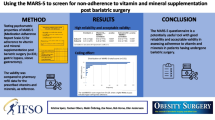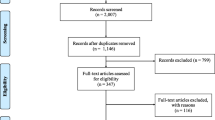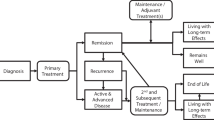Abstract
Background
The use of complementary and alternative medicines (CAM) has been reported to be frequent and increasing in the general population and among cancer survivors. Very few studies have investigated the use of CAM among long-term endometrial cancer survivors. To address this gap in evidence, this qualitative study aimed to understand the use of CAM and factors motivating the use among long-term survivors of endometrial cancer.
Methods
Semi-structured qualitative interviews were conducted with 17 women diagnosed with endometrial cancer 7–10 years previously, to understand their CAM use and its impact on their wellbeing. Thematic analysis was performed by two researchers to extract the most relevant quotes related to CAM products, practices, and practitioners.
Results
All 17 women interviewed used some type of CAM practices, practitioners, or products, specifically 94% concentrated on their diet, 88% focused on their exercise, 59% used a CAM product, 53% visited a CAM practitioner, and 18% used a CAM psychological approach. The main motivators for CAM use included to reduce physical and psychological symptoms, and to stop or reduce medications. Women reported a lack of lifestyle advice from their traditional medical healthcare team which they therefore tried to obtain from other sources.
Conclusions
Our findings suggest CAM practices, practitioners, or products form an important part of women’s healthcare options and are commonly used by long-term endometrial cancer survivors. Our data can be of importance to health care professionals and hospitals, as it reflects an unfulfilled need among cancer survivors that does not currently appear to be met by their traditional healthcare team.

Similar content being viewed by others
References
Ferlay J, Soerjomataram I, Dikshit R, Eser S, Mathers C, Rebelo M, Parkin DM, Forman D, Bray F (2015) Cancer incidence and mortality worldwide: sources, methods and major patterns in GLOBOCAN 2012. Int J Cancer 136(5):E359–E386. https://doi.org/10.1002/ijc.29210
Cramer D (2012) The epidemiology of endometrial and ovarian cancer. Hematol Oncol Clin North Am 26(1):1–12. https://doi.org/10.1016/j.hoc.2011.10.009
Australian Institute of Health and Welfare (AIHW) (2018) Cancer data in Australia. https://www.aihw.gov.au/reports/cancer/cancer-data-in-australia/acim-books. Access to 17 January, 2019
Le Boutillier C, Archer S, Barry C, King A, Mansfield L, Urch C (2019) Conceptual framework for living with and beyond cancer: a systematic review and narrative synthesis. Psychooncology 28(5):948–959
Laskey RA, McCarroll ML, von Gruenigen VE (2016) Obesity-related endometrial cancer: an update on survivorship approaches to reducing cardiovascular death. BJOG 123(2):293–298
Johnson S, Park H, Gross C, Yu J (2018) Use of alternative medicine for cancer and its impact on survival. J Natl Cancer Inst 110(1):121–124. https://doi.org/10.1093/jnci/djx145
Koczwara B, Beatty L (2011) Psychology of complementary care in cancer: motivators, barriers and outcomes. Cancer Forum 35(1):1–4
Truant TL, Porcino AJ, Ross BC, Wong ME, Hilario CT (2013) Complementary and alternative medicine (CAM) use in advanced cancer: a systematic review. J Support Oncol 11(3):105–113
Li C, Hansen RA, Chou C, Calderón AI, Qian J (2018) Trends in botanical dietary supplement use among US adults by cancer status: the National Health and Nutrition Examination Survey, 1999 to 2014. Cancer 124(6):1207–1215
Steel A, Mcintyre E, Harnett J, Foley H, Adams J, Sibbritt D, Wardle J, Frawley J (2018) Complementary medicine use in the Australian population: results of a nationally-representative cross-sectional survey. Sci Rep 8(1):17325. https://doi.org/10.1038/s41598-018-35508-y
Xue C, Zhang A, Lin V, Da Costa C, Story D (2007) Complementary and alternative medicine use in Australia: a national population-based survey. J Altern Complement Med 13(6):643–650. https://doi.org/10.1089/acm.2006.6355
Oh B, Butow P, Mullan B, Beale P, Pavlakis N, Rosenthal D, Clarke S (2010) The use and perceived benefits resulting from the use of complementary and alternative medicine by cancer patients in Australia. Asia Pac J Clin Oncol 6(4):342–349. https://doi.org/10.1111/j.1743-7563.2010.01329.x
Edwards GV, Aherne NJ, Horsley PJ, Benjamin LC, McLachlan CS, McKay MJ, Shakespeare TP (2014) Prevalence of complementary and alternative therapy use by cancer patients undergoing radiation therapy. Asia Pac J Clin Oncol 10(4):346–353. https://doi.org/10.1111/ajco.12203
Kristoffersen AE, Stub T, Salamonsen A, Musial F, Hamberg K (2014) Gender differences in prevalence and associations for use of CAM in a large population study. BMC Complement Altern Med 14:463
Correa-Velez I, Clavarino A, Eastwood H (2005) Surviving, relieving, repairing, and boosting up: reasons for using complementary/alternative medicine among patients with advanced cancer: a thematic analysis. J Palliat Med 8(5):953–961
River J, McKenzie H, Levy D, Pavlakis N, Back M, Oh B (2018) Convergent priorities and tensions: a qualitative study of the integration of complementary and alternative therapies with conventional cancer treatment. Support Care Cancer 26(6):1791–1797. https://doi.org/10.1007/s00520-017-4021-0
Peng W, Adams J, Hickman L, Sibbritt D (2014) Complementary/alternative and conventional medicine use amongst menopausal women: results from the Australian Longitudinal Study on Women’s Health. Maturitas 79(3):340–342. https://doi.org/10.1016/j.maturitas.2014.08.002
Markovic M, Manderson L, Wray N, Quinn M (2006) Complementary medicine use by Australian women with gynaecological cancer. Psycho-Oncology 15(3):209–220 https://doi-org.ezproxy.library.uq.edu.au/10.1002/pon.936
Witt CM, Balneaves LG, Cardoso MJ, Cohen L, Greenlee H, Johnstone P, Kücük Ö et al (2017) A comprehensive definition for integrative oncology. J Natl Cancer Inst Monogr. https://doi.org/10.1093/jncimonographs/lgx012
McLaughlin D, Lui CW, Adams J (2012) Complementary and alternative medicine use among older Australian women--a qualitative analysis. BMC Complement Altern Med 12:34. https://doi.org/10.1186/1472-6882-12-34
Welz AN, Emberger-Klein A, Menrad K (2019) What motivates new, established and long-term users of herbal medicine: is there more than push and pull? BMC Complement Altern Med 19(1):170. https://doi.org/10.1186/s12906-019-2584-7
Gyasi RM, Asante F, Yeboah JY, Abass K, Mensah CM, Siaw LP (2016) Pulled in or pushed out? Understanding the complexities of motivation for alternative therapies use in Ghana. Int J Qual Stud Health Well Being 11:29667. https://doi.org/10.3402/qhw.v11.29667 eCollection 2016
Sirois FM, Purc-Stephenson RJ (2008) Consumer decision factors for initial and long-term use of complementary and alternative medicine. Complement Health Pract Rev 13(1):3–19. https://doi.org/10.1177/1533210107310824
Shmueli A, Shuval J (2006) Satisfaction with family physicians and specialists and the use of complementary and alternative medicine in Israel. Evid Based Complement Alternat Med 3(2):273–278. https://doi.org/10.1093/ecam/nel009
Furnham A, Smith C (1988) Choosing alternative medicine: a comparison of the beliefs of patients visiting a general practitioner and a homoeopath. Soc Sci Med 26(7):685–689. https://doi.org/10.1016/0277-9536(88)90060-3
Ganguli SC, Cawdron R, Irvine EJ (2004) Alternative medicine use by Canadian ambulatory gastroenterology patients: secular trend or epidemic? Am J Gastroenterol 99(2):319–326. https://doi.org/10.1111/j.1572-0241.2004.04046.x
Verhoef MJ, Balneaves LG, Boon HS, Vroegindewey A (2005) Reasons for and characteristics associated with complementary and alternative medicine use among adult cancer patients: a systematic review. Integr Cancer Ther 4(4):274–286. https://doi.org/10.1177/1534735405282361
Janda M, Gebski V, Forder P, Jackson D, Williams G, Obermair A (2006) LACE trial committee. Total laparoscopic versus open surgery for stage 1 endometrial cancer: the LACE randomized controlled trial. Contemp Clin Trials 27(4):353–363
Janda M, Gebski V, Brand A, Hogg R, Jobling TW, Land R, Manolitsas T et al (2010) Quality of life after total laparoscopic hysterectomy versus total abdominal hysterectomy for stage I endometrial cancer (LACE): a randomised trial. Lancet Oncol 11(8):772–780. https://doi.org/10.1016/S1470-2045(10)70145-5
Janda M, Gebski V, Davies LC, Forder P, Brand A, Hogg R, Jobling TW, Land R, Manolitsas T, Nascimento M, Neesham D, Nicklin JL, Oehler MK, Otton G, Perrin L, Salfinger S, Hammond I, Leung Y, Sykes P, Ngan H, Garrett A, Laney M, Ng TY, Tam K, Chan K, Wrede CD, Pather S, Simcock B, Farrell R, Robertson G, Walker G, Armfield NR, Graves N, McCartney A, Obermair A (2017) Effect of total laparoscopic hysterectomy vs total abdominal hysterectomy on disease-free survival among women with stage I endometrial cancer: a randomized clinical trial. JAMA 317(12):1224–1233
Braun V, Clarke V (2006) Using thematic analysis in psychology. Qual Res Psychol 3(2):77–101
Bishop F, Yardley L, Lewith G (2007) A systematic review of beliefs involved in the use of complementary and alternative medicine. J Health Psychol 12(6):851–867. https://doi.org/10.1177/1359105307082447
Cassileth BR (1999) Alternative and complementary medicine. Separating the wheat from the chaff. Cancer 86(10):1900–1902
Loprinzi CL, Levitt R, Barton DL, Sloan JA, Atherton PJ, Smith DJ, Dakhil SR, Moore DF Jr, Krook JE, Rowland KM Jr, Mazurczak MA, Berg AR, Kim GP, North Central Cancer Treatment Group (2005) North central cancer treatment group. Evaluation of shark cartilage in patients with advanced cancer: a north central cancer treatment group trial. Cancer 104(1):176–182
Ernst E (1998) The prevalence of complementary/alternative medicine in cancer: a systematic review. Cancer 83(4):777–782. https://doi.org/10.1002/(SICI)1097-0142(19980815)83:4<777::AID-CNCR22>3.0.CO;2-O
Ben-Arye E, Samuels N, Goldstein LH, Mutafoglu K, Omran S, Schiff E, Charalambous H, Dweikat T, Ghrayeb I, Bar-Sela G, Turker I, Hassan A, Hassan E, Saad B, Nimri O, Kebudi R, Silbermann M (2016) Potential risks associated with traditional herbal medicine use in cancer care: a study of middle eastern oncology health care professionals. Cancer 122(4):598–610
Byard RW, Musgrave I, Maker G, Bunce M (2017) What risks do herbal products pose to the Australian community? Med J Aust 206(2):86–90
Myers SP, Cheras PA (2004) The other side of the coin: safety of complementary and alternative medicine. Med J Aust 181(4):222–225
Velicer CM, Ulrich CM (2008) Vitamin and mineral supplement use among US adults after cancer diagnosis: a systematic review. J Clin Oncol 26(4):665–673. https://doi.org/10.1200/JCO.2007.13.5905
Reid R, Steel A, Wardle J, Trubody A, Adams J (2016) Complementary medicine use by the Australian population: a critical mixed studies systematic review of utilisation, perceptions and factors associated with use. BMC Complement Altern Med 16:176. https://doi.org/10.1186/s12906-016-1143-8
Duncan M, Moschopoulou E, Herrington E, Deane J, Roylance R, Jones L, Bourke L, Morgan A, Chalder T, Thaha MA, Taylor SC, Korszun A, White PD, Bhui K, SURECAN Investigators (2017) Review of systematic reviews of non-pharmacological interventions to improve quality of life in cancer survivors. BMJ Open 7(11):e015860. https://doi.org/10.1136/bmjopen-2017-015860
Monti D, Yang J (2005) Complementary medicine in chronic cancer care. Semin Oncol 32(2):225–231
Ernst E (2005) Why alternative medicines are used. Pharm J 275(7357):55
Vincent C, Furnham A (1996) Why do patients turn to complementary medicine? An empirical study. Br J Clin Psychol 35:37–48. https://doi.org/10.1111/j.2044-8260.1996.tb01160.x
Funding
Monika Janda was funded by NHMRC Translating Research into Practice fellowship APP1151021. This project was part of LACE trial which was funded by the Cancer Council Queensland, the Cancer Council New South Wales, the Cancer Council Victoria, and the Cancer Council Western Australia; by project grant 456110 from the National Health and Medical Research Council, project grants 631523 and 1098905 from Cancer Australia, and a Smart health research grant from QLD Health; and funding from the Women and Infants Research Foundation, Royal Brisbane and Women’s Hospital Foundation, Wesley Research Institute, Gallipoli Research Foundation, Gynetech, Tyco Healthcare, Johnson & Johnson Medical, Hunter New England Centre for Gynaecological Cancer, Genesis Oncology Trust, and the Cherish Foundation.
Author information
Authors and Affiliations
Contributions
Conception and design: MJ, AO
Qualitative interview analysis: SS, LC, MJ
Drafting of manuscript: LC, SS, MJ
Critical revision and final approval of manuscript: All authors
Corresponding author
Additional information
Publisher’s note
Springer Nature remains neutral with regard to jurisdictional claims in published maps and institutional affiliations.
Rights and permissions
About this article
Cite this article
Caughey, L., Sanjida, S., Obermair, A. et al. The use of CAM products, practices, and practitioners by long-term endometrial cancer survivors in Australia. Support Care Cancer 28, 5479–5489 (2020). https://doi.org/10.1007/s00520-020-05404-1
Received:
Accepted:
Published:
Issue Date:
DOI: https://doi.org/10.1007/s00520-020-05404-1




